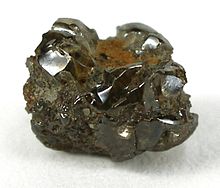Bort
| Bort (also boort or boart) | |
|---|---|
 A mixture of bort and gem diamonds (larger inclusions) from the Crater of Diamonds State Park | |
| General | |
| Category | Mineral variety |
| Formula (repeating unit) | C |
| Identification | |
| Color | varies (white to yellowish in powder form, yellow to brownish in larger shards) |
| Use/purpose | |
| Major varieties | |
| Similar occurrences | |
Bort, boart, or boort is an umbrella term used in the diamond industry to refer to shards of non-gem-grade/quality diamonds. In the manufacturing and heavy industries, "bort" is used to describe dark, imperfectly formed or crystallized diamonds of varying levels of opacity. The lowest grade, "crushing bort," is crushed by steel mortars and used to make industrial-grade abrasive grits. Small bort crystals are used in drill bits. The Democratic Republic of the Congo provides 75% of the world supply of crushing bort.[1][2][3]
Use and application

Apart from the use of bort in the diamond gem industry, where the material is used as an abrasive—with a hardness close to or the same as that of diamond itself—to scour and polish the various facets of gem stones, in smaller flakes and particles it is also used as an additive for scouring or polishing pastes and agents. Larger particles find their use as a protective and cutting edge to drill bits, saws and other (cutting) tools and machinery for longer lifespan and to substantially increase their efficiency (for instance, for tools that drill or saw through (reinforced) concrete—cement, stone (pebbles) and steel (rebar) alike—or other hard materials, both metal and non-metal).[4]
When bort particles varying from one to two nanometers[5] are added to lubricants such as paraffin oil, these particles will embed themselves into minute irregularities and imperfections of moving-part surfaces, whereas particles that remain suspended in the lubricant oil act as both a polishing agent further smoothening the surfaces, as well as ball bearings between the surfaces that move relative to or revolve within or around one another. Such nanotechnology applications with paraffin oil containing approximately 1% of these nano-size bort particles may decrease the friction up to half of that without the nano-particles.[6][7]
See also
- Carbonado (black diamond)
- Synthetic diamond
- Ballas
- Rough diamond
References
- ^ Spear, K.E; Dismukes, J.P. (1994). Synthetic Diamond: Emerging CVD Science and Technology. Wiley–IEEE. p. 628. ISBN 0-471-53589-3. Archived from the original on 2015-04-25.
- ^ Industrial diamond. Encyclopædia Britannica.
- ^ Bort. Encyclopædia Britannica.
- ^ MINES BUREAU (2010). Minerals Yearbook Metals and Minerals 2010 Volume I. pp. 21–22. ISBN 978-1-4113-3449-6. Archived from the original on December 30, 2018. Retrieved December 30, 2018.
{{cite book}}: CS1 maint: multiple names: authors list (link) - ^ Scientific notation in SI unit(s): 1–2 × 10−9 m.
- ^ Ballengee, Jason (2016). "Nanodiamond and Lubrication Applications" (PDF). aiche.org. SP3 NANOTECH, LLC. Archived (PDF) from the original on December 6, 2018. Retrieved December 6, 2018.
- ^ GEORGE, BEEKMAN (January 6, 1997). "Betere smering met behulp van zeer fijn diamantpoeder (Better lubrication using diamond powder of very small particles)". nrc.nl (in Dutch). NRC Handelsblad. Archived from the original on December 6, 2018. Retrieved December 6, 2018.
{{cite news}}: CS1 maint: multiple names: authors list (link)
